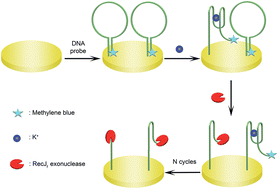An aptasensor for detection of potassium ions based on RecJf exonuclease mediated signal amplification
Abstract
An electrochemical biosensor for potassium has been developed combining specific potassium–aptamer binding and RecJf exonuclease mediated signal amplification. Generally, the DNA probe with a stem-loop structure containing an anti-K+ aptamer sequence is designed and modified on a gold electrode. K+ can specifically bind to the aptamer and a G-quadruplex structure forms, which breaks the original stem-loop structure. The induced single-stranded 5′ end can be further digested by RecJf exonuclease, releasing K+ which can bind to another DNA probe on the electrode. After cycles of RecJf exonuclease cleavage initiated by K+, the electrochemical signal intensity is significantly decreased, and can be used to determine the concentration of K+. This aptasensor shows high sensitivity, selectivity as well as excellent stability and accuracy, which provides possibilities for further applications of K+ assay in clinical diagnosis.


 Please wait while we load your content...
Please wait while we load your content...